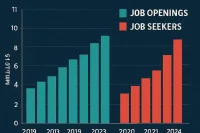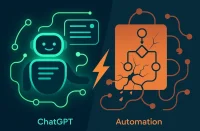The lazy way to become a programmer isn’t about shortcuts or get-rich-quick schemes—it’s about being smart enough to find the most efficient path to success. Everyone tells you breaking into tech requires endless hours, relentless grinding, and building project after project until your eyes look like that one Squidward meme. But what if I told you that approach is like using a chainsaw for heart surgery instead of a scalpel?
I use “lazy” very deliberately here because lazy people find the quickest, most efficient way to get something done so they don’t waste unnecessary time. If you don’t know me yet, my name is Phil. Seven years ago, I was a 30-year-old English teacher making barely enough to survive. I had zero programming experience and frankly zero natural talent for it either. But I was lazy enough to refuse the grind for 12 hours a day advice everyone was pushing.
Today, I’m a senior developer who’s earned over $300,000 annually and helped hundreds of people break into tech without burning out. My goal is to give you my no-filter, no-BS insights about life and lessons as a software engineer. These are my own thoughts based on my own experiences.
The Bell Curve Reality in Tech
The lazy way to become a programmer recognizes that the tech industry follows a bell curve distribution. It’s a graph that shows how most people or things fall around an average, with fewer at the extremes—it looks like a hill, high in the middle and low on both sides.
The Left Side: The Never-Make-It Group On the left, you have people who are never going to make it, regardless of whether it’s mindset, work ethic, or just bad timing. These people get sold the “just grind harder” narrative and burn out. They’re the ones who try the same approach over and over, expecting different results.
The Middle: The Brute Force Majority In the middle, you have the majority—the good people who rely on brute force strategies because they don’t know better. They spend 6 months in tutorial hell, build the same weather app as everyone else, and wonder why they can’t get interviews. Some make it work, but as the job market reflects, the majority can’t make it work.
The Right Side: The Strategic Upper Class Then on the right, you have the upper class. These people are always going to succeed—it was just a matter of when. They intuitively understand that programming isn’t about memorizing syntax. It’s about pattern recognition and problem-solving. They have that “IT” factor.
The Chainsaw vs. Scalpel Approach
The lazy way to become a programmer rejects the chainsaw approach that most people use. Most programming advice follows this brute force method: build 50 projects and you’ll eventually get good, grind LeetCode for eight hours a day, learn every framework and language. This works eventually, but it’s inefficient and soul-crushing.
The scalpel approach recognizes that programming follows the 80/20 rule religiously. Twenty percent of concepts give you 80% of the results. Twenty percent of your time spent strategically beats 80% spent grinding aimlessly. In short, focus on the activities that yield the greatest returns.
If you only need a scalpel to get the job done, why use a chainsaw? It’s heavier, consumes more energy, and is messy. This is what the people on the right of the bell curve use.
Why Traditional Bootcamps Miss the Mark
The lazy way to become a programmer avoids the common path that mirrors the chainsaw approach: traditional bootcamps. These teach you multiple languages simultaneously, covering any and every concept possible. Think about it—when you ultimately land your first offer, do you think they need you programming in every single language possible or using every concept created? Of course not. So why prepare that way?
The smarter, more efficient approach to becoming a programmer isn’t being taught widely because it requires a significant amount of initial mental effort and critical thinking. And frankly, most people don’t want to think. They just want to be told what to do for 40 hours a week.
The Lazy Programmer’s Framework
The lazy way to become a programmer follows a strategic four-step framework that focuses on efficiency over effort:
Step 1: Pattern Recognition Over Memorization
Instead of trying to memorize every method in JavaScript, focus on understanding the fundamental patterns. Once you see that most programming problems follow similar structures, you can solve new problems by recognizing which pattern applies.
When I study any new concept, I ask four questions:
- What is this?
- Why does this exist?
- When will I need this?
- How does this connect to what I already know?
These questions force your brain to build connections, not just store isolated facts like your own internal database.
Step 2: Strategic Project Building
Everyone says build projects, but they don’t tell you which projects actually matter. Here’s the lazy approach: pick one problem domain you understand better than most people. If you worked in retail, build retail solutions. If you understand fitness, build fitness apps. Don’t build another to-do list.
Build something that demonstrates you understand both the technical and business sides of a problem. This positions you as someone who can solve real problems, not just write code.
Step 3: The AI Advantage
The lazy way to become a programmer really shines in 2025 with AI tools. AI tools like GitHub Copilot and Claude can cut your development time in half, but only if you know how to use them strategically.
Instead of fighting AI, make it your research assistant:
- Use it to generate practice problems for active recall
- Explain complex concepts in simple terms
- Debug your code and explain why it broke
- Create multiple approaches to solve the same problem
The lazy programmer doesn’t compete with AI. They leverage it to focus on higher-level thinking.
Step 4: Strategic Mentorship
Here’s something the “grind alone or lock in or I’m cooked” crowd won’t tell you: even world-class athletes have coaches. LeBron James has coaches. Serena Williams had coaches. Yet somehow people think they should learn programming in complete isolation.
I get it. The internet is flooded with overpriced courses and programs that promise you’ll be making six figures in 60 days or something stupid. Most of them are scams, and you’re right to be skeptical.
But here’s the difference: good mentorship programs aren’t selling you shortcuts. They’re selling you the strategic thinking you need to avoid wasting years going in circles. When I was starting out, I spent months spinning my wheels because I didn’t know which 20% of concepts actually mattered.
A good mentor doesn’t just teach you to code. They show you which problems are worth solving and how to position yourself in the market. The lazy approach: find someone who’s already walked the path and can show you where the landmines are buried.
The Mindset Shift: From Coder to Problem Solver
The lazy way to become a programmer requires a fundamental mindset shift. What most people miss is that when you’re becoming a programmer, it isn’t about learning to code. It’s about becoming a problem solver who happens to use code as a tool.
When you shift from “how do I memorize this syntax” to “how do I solve this problem efficiently,” everything changes. You stop competing on who can grind the longest and start competing on who can think the clearest.
This approach requires more initial mental effort than the brute force method. It’s easier to follow a 40-hour per week bootcamp curriculum than to think strategically about what you actually need to learn. Most people choose the hard way because it feels like progress. Grinding for 12 hours feels productive. Strategic thinking for 2 hours feels like you’re being lazy.
The Reality of Strategic Learning
The lazy way to become a programmer delivers results while others burn out. While everyone else is burning out in tutorial hell, you’ll be building real solutions to real problems. While they’re memorizing syntax, you’ll be recognizing patterns. While they’re competing for entry-level positions, you’ll be positioning yourself as someone who understands both technology and business.
The path I’m showing you works. I’ve seen it work for hundreds of students, but it requires you to think differently about learning. Breaking into tech in 2025 isn’t about who can suffer the most or grind the longest. It’s about who can think strategically and execute efficiently.
Now more than ever, AI is drastically cutting the learning curve and time it takes to become proficient in something. The lazy way isn’t the easy way—it’s the smart way. And in tech, smart always beats hard.
Hire Smarter, Not Harder
Strategic learners don’t just memorize syntax—they solve real problems and bridge tech with business. Employers can future-proof their teams by hiring developers who think differently and leverage AI to accelerate results. Post your job on WhatJobs today and connect with talent that learns fast, adapts quickly, and executes efficiently.
Post a Job Free for 30 Days →The 80/20 Rule in Action
The lazy way to become a programmer leverages the 80/20 rule in every aspect of learning:
20% of Programming Concepts = 80% of Results Focus on fundamental patterns, not syntax memorization. Learn the core concepts that apply across languages and frameworks.
20% of Projects = 80% of Interview Success Build projects that solve real problems in domains you understand, not generic tutorials that everyone else builds.
20% of Time = 80% of Learning Spend your time strategically on high-impact activities rather than grinding through endless tutorials.
20% of Skills = 80% of Job Performance Master the core skills that matter most: problem-solving, pattern recognition, and business understanding.
Frequently Asked Questions
Is the lazy way really effective for learning programming?
The lazy way to become a programmer is actually more effective because it focuses on strategic learning rather than brute force. By concentrating on the 20% of concepts that yield 80% of results, you learn faster and retain more information.
How do I know which 20% of concepts to focus on?
The lazy way to become a programmer involves studying job descriptions, talking to working developers, and focusing on fundamental patterns that apply across different technologies. A good mentor can help you identify these high-impact areas.
Can I really become a programmer without grinding for 12 hours a day?
The lazy way to become a programmer proves that quality beats quantity. Two hours of strategic learning often produces better results than 12 hours of aimless grinding. The key is focusing on the right activities.
How do I find a good mentor without falling for scams?
The lazy way to become a programmer suggests looking for mentors who focus on strategic thinking rather than promising quick results. Good mentors teach you how to think, not just what to memorize.
A Real-World Example: Sarah’s Strategic Success
Sarah Chen, a 28-year-old marketing professional from Austin, exemplifies how the lazy way to become a programmer can transform your career. After spending six months in tutorial hell, Sarah discovered the strategic approach.
“I was building the same weather apps as everyone else and getting nowhere,” Sarah explains. “Then I realized I should leverage my marketing background. I built a customer analytics dashboard that solved real problems I understood from my previous work.”
Sarah’s strategic approach paid off immediately. “Instead of competing with hundreds of generic developers, I positioned myself as someone who understood both technology and business. I got three job offers within two months of changing my approach.”
Sarah’s story demonstrates that the lazy way isn’t about shortcuts—it’s about working smarter, not harder. By focusing on her unique strengths and building projects that showcased both technical and business skills, she accelerated her career transition.
The lazy way to become a programmer isn’t about being lazy—it’s about being smart enough to find the most efficient path to success. If I can do it, you can do it too. Coding saves lives.




